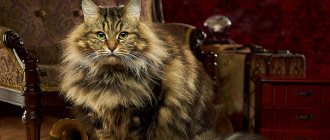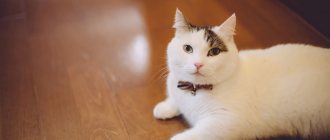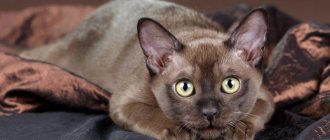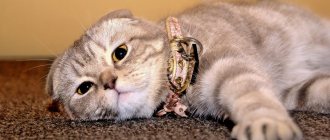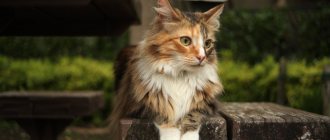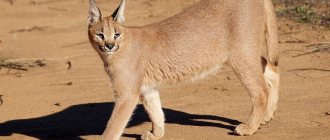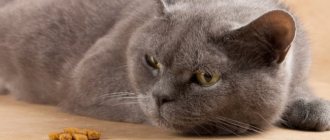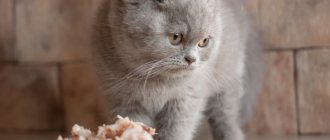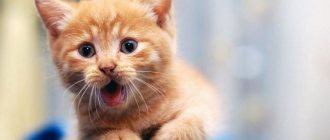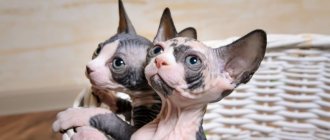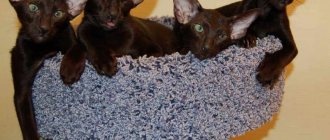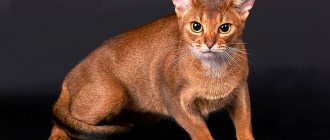Folding ears are associated with the specific structure of the ears. This property was recorded in Scotland in 1961, when breeders began to deliberately breed lop-eared kittens. Hence the second name of this breed – Scottish.
Scientists have discovered that this ear structure is a gene mutation, with lop ears being a dominant gene. When two fold-eared cats are crossed, weak kittens are born. In order for the offspring to be healthy, one parent must have fold ears, and the other must have straight ears. When purchasing, find out which cats your future pet comes from. This will save you from choosing a purebred but sick kitten.
Newborn fold kittens
Kittens in a litter from a fold-eared parent and a straight-eared parent are different, but they can be distinguished from each other after 2-3 weeks.
British and Scottish ears
Important! It is recommended to buy a fold kitten when it is 6 weeks old. At earlier stages, you risk paying a large sum and finding that the kitten's ears will straighten over time.
External signs of lop ears
A fold-eared kitten has structural features of the entire body, and not just the ears. These include:
- The nose is without humps, which can be determined by touch.
- The tail is smooth, without humps or knots.
- Wide muzzle.
- Round head.
- Small cheeks.
- Wide eye set.
- Large chest.
- The legs and tail are shorter and larger than those of their straight-eared counterparts.
- Plush wool.
External signs of fold-eared cats
Interesting! Fold cats are long-haired - Highland Folds, and short-haired - Scottish Folds.
Types of British and Scottish cats
Highland fold
Scottish fold
Shaded (shedded) colors
An unusual definition refers to the interesting color of Scottish cats - shaded colors. These pets have almost white fur, but the tip of the guard hair is colored.
The top layer of a cat's coat can be any shade typical of Scottish cats. The undercoat is white. The sides, back, head, tail and ears are shaded. Light belly, chin and lower tail. There should be no obvious spots. The “M” sign on the forehead and darkish rings on the paws are acceptable.
Shedded colors can be of three varieties:
- Golden. The fur of the Scottish cat is golden, the undercoat is cream or light peach. Green eyes are very expressive and beautiful. The nose button and paw pads are chocolate.
- Red. This type of shaded color has a dark red coating on the coat with a snow-white undercoat. The eyes are amber, the pads and nose are pink.
- Silver. The white undercoat combined with the dark gray topcoat produces an amazing gray tint. Greenish eyes are lined with black stripes. This feature is typical only for the silver shedded color. Other varieties have eyes without a contour. The nose is brick-colored and the mouth is dark-lined.
Loss of characteristic: when the ears rise
Straight-eared kittens are called straights, and fold-eared kittens are called folds. The clear difference between them lies in the presence and number of folds on the ears. One fold causes the ears to straighten over time. This does not mean that the kitten is straight. To answer the question about his breed, an examination is carried out. It is especially important for owners who plan to crossbreed kittens. An incorrect conclusion about the straightness of an animal leads to the crossing of two lop-eared individuals and sick offspring. If there are two folds, then it is impossible to predict the outcome: the kitten can remain fold-eared with the same success as become straight-eared. Three folds ensure the ears don't straighten out.
External differences between British and Scottish cats
Folds with erect ears are sterilized to prevent the transmission of a dominant gene that has lost visual expression.
There is a clear sign that distinguishes a fold-eared cat with erect ears from a straight-eared one: the size of the ears. The first one has smaller ones.
Temporary changes in the position of the ears are also possible, the cause of which is weather conditions. The heat causes the Fold's ears to rise slightly.
Important! To purchase fold-eared kittens, choose a time of year with moderate temperatures.
In addition, the ears of the folds also rise in females after giving birth.
Video - Scottish Fold cat
Color codes
Cat identification is supported by both WCF (World Cat Federation) and FIFe (Federation Internationale Feline). It is not so difficult to understand it, and in the future there will be no problems determining the breed and characteristics of the animal you like.
The breed code looks like this: ХХХ.хх.NN.NN.NN.(NN). The decoding of this “formula” is as follows: XXX – large English letters of the name of the breed, example:
- SFL – Scottishfold.
- SFS – Scottish Strike.
- BRI - British.
- MAN – cat o. Maine, and further down the list.
Next come two lowercase English letters - xx. The first one represents the base color. Example:
- n – black color.
- w – white color.
- g – blue-cream turtle, and so on.
There are only two second letters: s – silver and y – golden. Example: ns – black silver (smoky), ny – black gold. Other pairs of numbers, when needed, now the last pair is not used. Number one indicates the type of feature, the second – the feature itself, it looks like this:
- if the number is 0 – the presence of a white color scheme.
- 1 – degree of tipping for silver colors.
- 2 – indicates the type of pattern in tiger colors.
- 3 – determines the type of point color.
- 5 – determines the length of the tail.
- 6 – eye coloring.
- 7 – ear placement.
Now examples:
03 – two-tone bicolor. 11, shaded, ¼ of the end part of the hair is darkened. 23 – tabby color. 34 – Singapore color. 51 – taillessness. 63 – disagreement. 73 – fold. 71 – straight and so on.
Now let's look at a few examples:
SFSns2271 – black and silver marbled Scottish strike. Here 22 are marbled, 71 are straight ears. Next: BRIw63 is a white British man with different eyes. MANg226251 – cat o. Maine, blue-cream turtle, tailless, eyes, orange. Here 51 are tailless, 62 are orange eyes.
Adding to the family: how to care for a mother and her newborns
In the first weeks after the birth of kittens, providing proper care is the key to healthy babies and cats. The list of necessary actions on the part of the owners is as follows:
- Provide a warm, dry box for mother and kittens.
- Place a white sheet over it to help track your cat's waste.
- Provide your cat with a balanced diet.
- Organize constant access to water for babies and mothers.
- Do not try to separate the kittens from the cat.
The last point determines the development of the kitten and its viability. If you separate small pets from their parents, you can cause physical harm to them, because the bones are still fragile during this period, deprive the kittens of milk, which is responsible for their immunity, and disrupt their psychological state.
Creating favorable conditions for cats and newborn kittens
Care
Caring for Highland Folds is easy. They need to choose the right diet to maintain health in general and joints in particular.
It is also important to monitor portion sizes in nutrition, because... these cats tend to gain excess weight if they overeat.
They need to be brushed about once a week; during shedding, this will have to be done every day. You can bathe approximately once every 2 months, but if the animal is not a show animal, then it needs bathing as it gets dirty. This breed does not need a haircut.
You will have to brush your teeth and ears as needed, and trim the tips of your claws at the owner’s request.
Article continues after advertisement
If you walk a Highland Fold cat outside, you should definitely inspect its ears after this: ticks easily “stick” to the long hair and become attached to the ears, but the cat will not be able to remove them on its own.
Representatives of this breed easily get used to scratching posts and litter boxes, so in most cases there are no problems with training.
The first months of life of Scottish Fold kittens
In the first weeks of life, kittens go through stages from helplessness and huddling around their mother to independent activity and exploration of their environment.
On day 10, their eyes open: they feel more confident and begin to crawl around the cat. After a month, the kittens are fed food that will be their diet throughout their lives. At the same time, they leave the boxes that served them as shelter during the helpless period of life and master the surfaces. This is a favorable period for training a kitten to use a litter tray.
Color genetics
Kittens' eye color gradually changes: from dull blue to their real color. This process takes up to 2 years and is called reblooming. The inclusions appear first, which then spread and provide a permanent color. Green eyes take the longest to form.
Two-color
A unique coat color is bicolor (two-color cats). The main background is snow-white. The second color in color (cream, black, blue, red) is presented in the form of unusual patterns. Thoroughbred representatives must have white belly, neck, chest, paws, muzzle and beard.
A prerequisite is the predominance of a white background in color. Bicolors are more valued; their body patterns are symmetrical. The eyes can be any shade, but are usually blue or golden yellow.
Cream bicolor
Cute white cats with additional streaks of delicate cream tones. The eyes are blue or yellow, and the nose and pads are pink.
Blue bicolor
The pattern on the wool is blue (delicate or rich gray). The iris of the eyes is a beautiful sky tone or yellow-orange. The nose and paws below are pink.
Black bicolor
Black and white bicolor is characterized by patterns of rich black tone. These cats have a pink nose and blue or copper eyes. A symmetrical, distinct pattern on the skin turns the cat into a real gentleman in a tailcoat.
Constant sleep of newborns - an alarming signal or normal development of the body
Newborn kittens sleep up to 22 hours a day. This is not a cause for concern, because at this time the baby’s nervous system is developing. Sleep contributes to the favorable course of this process. In the first months, the kitten should not be separated from its mother and brothers and sisters. If his weight is normal, it means that development is proceeding normally, and constant sleep is conducive to this.
Newborn kittens sleep up to 22 hours a day
You can familiarize yourself with sleep norms for the initial stages of a kitten’s life in the table.
| Age | Image | Number of hours of sleep |
| Newborn | 22 | |
| 3 weeks | 16 | |
| 1 month | 15-20 |
In order for a kitten to switch to nighttime sleep mode, it should be provided with sufficient activity during the day: play, run. Thus, by night he will be tired, sleep will be necessary to restore strength and will coincide with the biorhythms of the owners.
Preparing a place for a kitten
For a joyful event - the appearance of a Scottish fold kitten in the house - you need to prepare in advance . The necessary dowry for a baby must include:
- dishes - several bowls (preferably ceramic) of different capacities for food and water;
- conveniently designed tray;
- litter of the kitten’s usual brand;
- hygiene and care items - brushes for combing and cleaning teeth, metal combs, a massage glove, zoo cosmetics, a nail clipper, several towels and diapers made of natural hygroscopic material;
- 5-6 toys of different types that develop reaction, mobility, intelligence;
- scratching post;
- a shelter house for sleep and rest (at first you can use the carrier in which the Scottish cat arrived from the nursery).
Proper arrangement of the area where the kitten will feel comfortable and safe is very important: how the adaptation to the new home proceeds largely determines the pet’s further behavior, the formation of stable useful habits and skills. It is advisable to close the room in which the baby will spend the first days, placing a tray, food and water there.
You can sit with him, talking with affectionate intonations, try to interest him in a toy, and then leave, giving him a few hours to look around. Once he gets used to it, he will make it clear that he is ready to explore new spaces. There is no need to rush or limit the kitten’s desire to explore other corners of the house. The adaptation period, if the owner does everything correctly, lasts 2-3 days, and after a week the baby will finally cope with the stress caused by the move and get used to the new environment.
Return to content
Periodization of the kitten's life stages. The first stage - mom is nearby
Kittens grow up to 1 year, during which significant changes occur every month. At the same time, 2-2.5 years is the period when the body finally gets stronger and becomes an adult.
| Age | Image | Peculiarities | Recommendations |
| First week | Weight – 100 g. Body length – 9-12 cm. No hearing until the 4th day. Eyes don't open. Undercoat appears. The umbilical cord separates on the 3rd day | Food is mother's milk, which the baby senses through olfactory receptors and consumes naturally. Antibodies contained in cat milk help an unvaccinated kitten resist infections. Do not disturb the unity of the kitten and the cat, so as not to scare the baby | |
| Second week | Weight - 250 g. By the end of this period, the eyes open; at first, the eye color of all kittens is cloudy blue. Attempts to walk, crawl away from the mother by 30-50 cm. | Stroke the kitten gently. Do not cause aggression on the part of the mother cat, who is worried about the younger generation at their first manifestations of independence | |
| Third week | Weight – 300 – 350 g. Support on 4 legs. On days 15-17 they begin to see. Orientation in distances. First milk teeth. Scratching behind the ear. Interest in playing with people | Play with kittens without sudden movements. Do not leave small children and kittens unattended | |
| Fourth week | Weight – 450 g. Approximately 26 teeth | Organize worm prevention. Drink filtered water from shallow bowls. Provide the kitten with constant access to water | |
| Fifth week | The cat reduces the level of care for the baby. The kitten learns to wash itself. The fur becomes brightly colored | Stock up on age-appropriate liquid food. Include solid foods in your diet. Provide the kitten with constant access to food (100 grams of food is the norm). Do not allow your baby to eat from adult bowls. Organize a pet house |
Mr. Cat recommends: character traits
Cats of this breed have an amazing, gentle and peaceful character in the cat family, even among domestic cats. They become very attached to a person, while most of their brothers still rather experience tender feelings for a specific place. They need manifestations of love and care, love affection and sitting on laps.
Many Highland Folds have one peculiarity: when they are interested or surprised by something, they sit down on their hind legs, reminiscent of a meerkat.
If there are children or other animals in the house, even those that naturally cause a hunting stance in the cat, you don’t have to worry: Highland Folds get along well with all representatives of the fauna, including dogs, rodents and birds. As a rule, they treat strangers without fear and wariness, they willingly go into their arms and allow themselves to be stroked. They generally like people's attention.
If people are busy, then the Highland Fold will not persistently pester, demand games or other forms of attention. They will perfectly find something to do on their own. At the same time, cats of this breed are very careful; as a rule, they do not pay attention to furniture, curtains and other interior items in order to sharpen their claws or otherwise damage them.
Kittens of this breed, like other kids, love to play and run, so the pet needs to prepare cat entertainment and toys in advance. They love to play with people, but you can safely leave them with children: they are absolutely not aggressive, they will not scratch or bite.
As cats mature, they become calmer, even sedate. If the owners are constantly at work, this does not cause any discomfort to the Highland Fold; he easily remains alone, but is very happy when people come. However, for this cat, schedule, order, and feeding at certain times are extremely important. She really doesn’t like the lack of orderliness, especially if there are interruptions in meals.
The second stage is independence and growing up
| Age | Image | Peculiarities | Recommendations |
| Sixth week | The final transition from mother's milk to foreign food | Feed the kitten 6 times a day, 40 grams of food at each meal. Observe the animal's stool; if there are any problems, contact a veterinarian after 3 days. | |
| Seventh week | Weight – 550-900 g. Males stand out among females in size | The kitten should not drink its mother's milk. Balance of dry and liquid food | |
| Eighth week | Weight – 750 – 1200 g. All milk teeth. Eats solid food | Separate from mother. Get examined by a veterinarian. Monitor the condition of your ears and eyes. Comb | |
| Ninth week | Forming a type of relationship with the owners | Get vaccinated | |
| Tenth week | Weight – 850-1400 g. Independence. Sensitivity to learning | Do not be aggressive in training | |
| Eleventh week | Research stage: exploring the corners of the apartment | Prevent the kitten from colliding with dangerous objects: close windows, remove small parts, toxic substances | |
| Twelfth week | Weight – 900-1600 g. Change of eyes Pet’s response to its name, to the call for food | Organize repeated prophylaxis against worms. Stop kitten aggression | |
| Thirteenth - fifteenth weeks | Weight – 1.5 kg. Molars appear | Feed 5 times a day. Trim nails regularly | |
| Sixteenth week | Weight – 1.8 kg | Get vaccinated | |
| Five months | Weight – 2 kg | Feed 4 times a day. Get a rabies vaccination | |
| Six months | Strong molars. Dimensions of an adult animal. Puberty | Organize worm prevention. Feed 3 times a day. Sterilize if there is no goal to breed offspring | |
| Seven months | Seasonal molt | Brushing your pet | |
| Eight – nine months | The cat is almost an adult | Sterilize if not done before. Consult your doctor about vaccination | |
| Ten – eleven months | Adult phase of life | Include food for adult cats in the diet |
Cat vaccination periods
Important! When the cat turns one year old, his diet should consist only of food for adults, and meals should be reduced to 2 per day.
Nutrition
Most cats of this breed are not prone to obesity and do not overeat. You can feed your Scotsman both ready-made food and natural food; only human food from the table is not suitable for a cat. Your pet must be accustomed to a certain diet right away, from childhood.
Feeding your pet with industrial food is the best solution for working, very busy people. Manufacturers of premium food take into account the various characteristics of cats, including age, so each pet can be given suitable nutrition, taking into account its individuality. The main thing is that the food is of high quality, from a reputable brand. They include not only the nutrients the animal needs, properly balanced, but also vitamins, minerals and other compounds. That is, they provide a complete diet, and the owner does not have any worries.
If the owners have opted for natural food, they will have to prepare food for their pet separately. The diet of an adult animal should mainly consist of protein foods, since cats are carnivores, their gastrointestinal tract is adapted to digesting soft fibers of meat.
The basis of nutrition should be lean meat and poultry. Meat by-products, porridge, and vegetables are also allowed; cottage cheese, fermented baked milk, and yogurt are required.
There is no need to give milk: after the kitten reaches the age of breastfeeding, it does not produce enough enzymes to digest whole food. It is sometimes possible to pamper your cat with fish, especially if she loves it, but this is often not recommended. In cats with a fish diet, the risk of developing urolithiasis and cholelithiasis greatly increases.
Determining the age of a fold-eared kitten
| Way | Sign | Age |
| External signs | Umbilical cord | A few days |
| Open eyes | At least a week | |
| Open ear canals | 5-8 days | |
| Erupting incisors | 2-3 weeks | |
| The eyes have opened, but not completely yet | 2-3 weeks | |
| Milk fangs | 3-4 weeks | |
| Changing eye color | 6-7 weeks | |
| All baby teeth | 4 months | |
| All molars | 7 months | |
| Behavioral signs | The kitten starts to walk | 2-3 weeks |
| The kitten can roll over in the air | 3-4 weeks | |
| Responsive to outside noise | 3.5 weeks | |
| Kitten running | 5 weeks | |
| The cat does not feed the kitten | 7 weeks | |
| Signs of puberty | Loud meowing, attempts to run away from home | 4 months |
| Males mark territory | 4 months | |
| First heat in females | 4-6 months | |
| Attacking other kittens to establish dominance | 7 months |
Characteristics of the Scottish Fold cat breed
Important! At 7-8 months, the kitten should pay special attention, since it is at this time that it socializes and gets used to the company of people.
